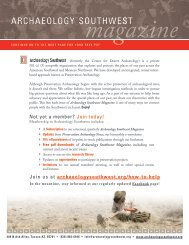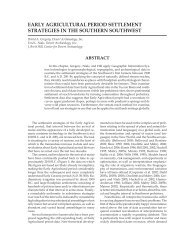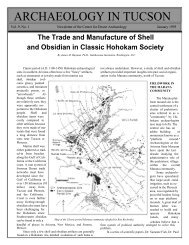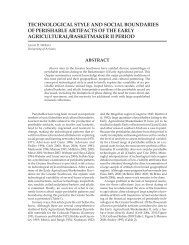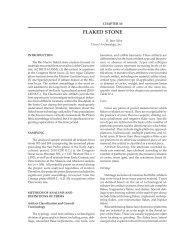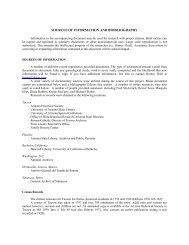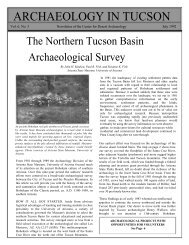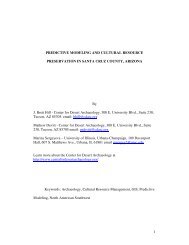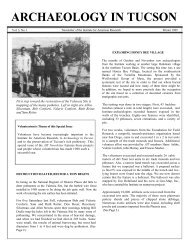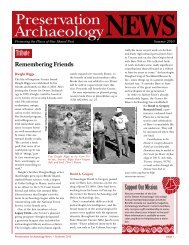Watson (PDF) - Archaeology Southwest
Watson (PDF) - Archaeology Southwest
Watson (PDF) - Archaeology Southwest
Create successful ePaper yourself
Turn your PDF publications into a flip-book with our unique Google optimized e-Paper software.
BIOARCHAEOLOGY OF THE FIRST FARMERS<br />
IN THE SONORAN DESERT<br />
James T. <strong>Watson</strong><br />
Arizona State Museum<br />
ABSTRACT<br />
Several hundred human burials have been recovered from Early Agricultural<br />
period (1200 B.C.-A.D. 50) sites located throughout the Sonoran Desert. These<br />
burials represent a substantial sample of the earliest farmers from the North American<br />
desert west and provide a unique insight into how the transition to an agricultural<br />
lifeway affected the health and lives of these peoples. The burial samples<br />
represent similar numbers of males and females of all adult age groups, lack juvenile<br />
remains, and demonstrate a wide variety of burial practices. Stature estimates<br />
reveal that these were generally relatively tall individuals, and limited evidence<br />
of infectious and degenerative diseases indicate the population enjoyed very good<br />
health. However, a high rate of trauma, some of which was violent in nature,<br />
suggests a significant level of conflict. Oral health was generally poor, although<br />
high rates of caries and tooth loss were likely the result of a balanced diet that<br />
relied on highly cariogenic resources of local cactus, as well as a reliance on domesticated<br />
corn. This mixed subsistence economy appeared to have remained relatively<br />
stable for nearly 2,000 years, but evidence from tooth wear indicates mechanical<br />
processing of existing resources may have intensified during the Cienega<br />
phase (800 B.C.-A.D. 50).<br />
The foraging to farming transition represents one<br />
of the most profound changes in human behavior<br />
during the last 10,000 years. Ramifications of this<br />
change have enduring effects on human health, offering<br />
insights into the etiology and distribution of<br />
many modern diseases. The global effects of subsistence<br />
changes to human health have been well documented<br />
in numerous studies of prehistoric burials<br />
(for synthetic treatments, see Cohen and Armelagos<br />
1984; Cohen and Crane-Kramer 2007; Larsen 2000;<br />
Steckel and Rose 2002). The shift to greater reliance<br />
on domesticated cultigens and animals caused a<br />
general decline in human health (Cohen and<br />
Armelagos 1984), related to increasingly aggregated<br />
sedentary populations and changes in diet and nutrition.<br />
Larger sedentary populations created poor<br />
sanitary conditions, which promoted the spread of<br />
communicable diseases (Goodman et al. 1984;<br />
Larsen 1997, 2000, 2002). Changes in subsistence<br />
activities, dietary breadth, and diet composition<br />
caused more dental disease and created nutritional<br />
inadequacies (Nelson et al. 1994; Steckel et al. 2002).<br />
The primary goal of this paper is to examine a suite<br />
of biological characteristics that are often impacted<br />
by cultural processes, including demography, health<br />
and disease, and diet, to identify patterns associated<br />
with the transition to agriculture among the earliest<br />
farmers in the Sonoran Desert.<br />
To date, just fewer than 400 human inhumation<br />
burials have been recovered from Early Agricultural<br />
period (1,200 B.C.-A.D. 50) sites in the Sonoran Desert;<br />
these remains represent the earliest PreColumbian<br />
inhabitants of the region. Very few burials have<br />
been found that predate this Early Agricultural<br />
sample, not just within the Sonoran Desert, but<br />
throughout the North American desert west (Mabry<br />
1998). Only three inhumations thought to be associated<br />
with the Middle Archaic period have been previously<br />
identified, estimated to date between about<br />
3,800 and 1,200 B.C. Toward the end of the Early<br />
Agricultural period, a major shift occurs in cultural<br />
practice of mortuary ritual as cremation burial appears<br />
and becomes increasingly common (Mabry<br />
1998; <strong>Watson</strong> and Cerezo-Román 2010). This pattern<br />
continues until inhumation burial again gains some<br />
popularity during the Hohokam Classic period (A.D.<br />
1150-1450) (Reid and Whittlesey 1997).<br />
Therefore, the Early Agricultural period burials<br />
are extremely important for several reasons. First<br />
and foremost, as the largest sample of early inhabitants<br />
of the Sonoran Desert, skeletal remains<br />
provide an important way to reconstruct population
2 The Latest Research on the Earliest Farmers<br />
composition, movement, and relationships with descendant<br />
communities. Second, as the earliest farmers<br />
and the first people to settle permanent villages<br />
in the region, this sample is important to address<br />
some of the major questions about human groups,<br />
their adaptations, and their diet and health during<br />
the introduction of agriculture. Finally, given the<br />
dearth of inhumation burials from the Sonoran Desert,<br />
the sample is an important source of information<br />
about the people who called this area their<br />
home.<br />
To date, 14 Early Agricultural period sites from<br />
southern Arizona and northern Sonora have produced<br />
approximately 387 human inhumation burials<br />
(Table 1). Radiocarbon dates directly associated<br />
with burials range between 3,100 B.C. and A.D. 200.<br />
These span the entire duration of both the Cienega<br />
(800 B.C.-A.D. 50) and the San Pedro (1200-800 B.C.)<br />
phases, as well as some portion of the unnamed<br />
phase (2100-1200 B.C.) just prior. Several other sites<br />
with Early Agricultural components have produced<br />
fragmented remains, although these are very limited<br />
and not useful for reconstructing a larger picture<br />
of demography, health, and diet of these early<br />
farmers. Additionally, many of these sites produced<br />
cremation burials that can be attributed to the terminal<br />
end of the Early Agricultural period. However,<br />
the fragmented nature of these burials precludes<br />
their use in comparisons with the more<br />
numerous and temporally expansive inhumation<br />
samples.<br />
An examination of Table 1 shows that the majority<br />
of the Early Agricultural period burials (n = 286)<br />
were recovered from a single site, La Playa, SON<br />
F:10:3 (ASM), located in north-central Sonora,<br />
Mexico (Figure 1). The next largest skeletal collection<br />
is 24 individuals from the Wetlands site, AZ<br />
AA:12:90 (ASM) (Guthrie and Lincoln-Babb 1998).<br />
Although only 13 of the burials from La Playa have<br />
been directly dated to the San Pedro phase, as many<br />
as 80 individuals may be associated with this early<br />
phase, based on burial depth and stratigraphic association<br />
(<strong>Watson</strong> 2005). Several of these early burials<br />
may actually predate the arbitrarily defined start<br />
of the Early Agricultural period. These significant<br />
disparities in the numbers of burials highlight one<br />
of the major differences between La Playa and the<br />
other sites.<br />
With few exceptions, the other burials have been<br />
recovered from archaeological cultural resource<br />
management projects, which are often restricted to<br />
the limits of the project area, forcing archaeologists<br />
to excavate only a fraction of the site. In contrast,<br />
recovery at La Playa has been largely driven by academic<br />
research and has been focused equally across<br />
the entire expanse of the site, the majority of which<br />
is confined to about a 4-km 2 area (<strong>Watson</strong> 2005). Unfortunately,<br />
the large number of burials recovered<br />
from La Playa are the direct result of extensive erosion.<br />
This has been a limiting factor for the study<br />
given that many of the burials, then, have poor context<br />
and few direct associations with other features<br />
or absolute dates. These erosive processes have<br />
vastly limited the contextual control over the burials.<br />
This has not been a problem at any of the other<br />
Early Agricultural period sites where spatial and<br />
chronological controls are fundamental elements to<br />
the excavations.<br />
Despite the wide geographic distribution of these<br />
Early Agricultural period burials (see Figure 1),<br />
many similarities have been identified between these<br />
sites and the skeletons recovered from them. As<br />
opposed to subsequent occupations in the Sonoran<br />
Desert, the Early Agricultural period inhabitants<br />
appear to have shared many cultural and biological<br />
traits across this expanse (<strong>Watson</strong> and Cerezo-<br />
Table 1. Early Agricultural period skeletal samples, by site and archaeological phase.<br />
Site Name ASM Site No. n Phase Citation<br />
Clearwater AZ BB:13:6 2 Cienega Diehl 1997<br />
Coffee Camp AZ AA:6:19 3 Cienega Dongoske 1993<br />
Donaldson AZ EE:2:30 5 Cienega Minturn and Lincoln-Babb 1995<br />
La Playa SON F:10:3 286 San Pedro (13), Cienega (25) <strong>Watson</strong> 2005<br />
Las Capas AZ AA:12:111 15 San Pedro McClelland 2005<br />
Los Morteros AZ AA:12:57 3 Cienega Wallace 1995<br />
Los Ojitos AZ EE:2:37 10 Cienega Minturn and Lincoln-Babb 1995<br />
Los Pozos AZ AA:12:91 23 Cienega McClelland 2005<br />
Pantano AZ EE:2:50 3 Cienega McClelland 2005<br />
Rillito Fan AZ AA:12:788 2 Cienega Wallace 1996<br />
Santa Cruz Bend AZ AA:12:746 8 Cienega Minturn et al. 1998<br />
Stone Pipe AZ AA:12:745 1 Cienega Minturn et al. 1998<br />
Valley Farms AZ AA:12:736 2 San Pedro Staten 2000<br />
Wetlands AZ AA:12:90 24 Cienega Guthrie and Lincoln-Babb 1998
Bioarchaeology of the First Farmers in the Sonoran Desert 3<br />
Figure 1. Location of Early Agricultural period sites in the Sonoran Desert.<br />
Román 2010). Some comparisons will be made between<br />
site groupings to demonstrate similarities<br />
within the region, but the majority of the following<br />
analyses and generalizations consider the burials<br />
from all the Early Agricultural period sites as one<br />
skeletal assemblage, representing a biologically and<br />
culturally related population encompassing most of<br />
its inherent variability. Preservation of skeletons<br />
from these sites is highly variable and largely guided<br />
by site-specific taphonomic processes, such as soil<br />
chemistry, discovery techniques, and erosion. However,<br />
these samples have provided a wealth of information<br />
about the early farming populations in<br />
the Sonoran Desert.<br />
MORTUARY TREATMENT<br />
The Early Agricultural period mortuary practice<br />
is dominated by the almost exclusive use of inhumation<br />
burial (Mabry 1998; <strong>Watson</strong> and Cerezo-<br />
Román 2010). This pattern changes during the<br />
Cienega phase, however, with the beginning of cremation,<br />
after which time cremation becomes equally<br />
important or even the dominant form of mortuary<br />
treatment (<strong>Watson</strong> and Cerezo-Román 2010). Cremations<br />
likely associated with the terminal portion<br />
of the Early Agricultural period have been recorded<br />
at three sites, including Coffee Camp, AZ AA:6:19<br />
(ASM) (Dongoske 1993), La Playa (Carpenter et al.<br />
2005; <strong>Watson</strong> et al. 2006), and Stone Pipe, AZ<br />
BB:13:425 (ASM) (Minturn et al. 1998). It is likely,<br />
however, that cremations from several of the other<br />
sites in the sample could be associated<br />
with the transition to the ceramic<br />
period, although they have<br />
not been directly dated. The nature<br />
of, and processes involved in, the<br />
transition to cremation burial in the<br />
Sonoran Desert have been addressed<br />
elsewhere (<strong>Watson</strong> and<br />
Cerezo-Román 2010), and therefore,<br />
are not considered here. Further,<br />
because the exact timing and<br />
extent of cremation burial is inadequately<br />
understood, and because<br />
cremations compose a very small<br />
percentage of burials dating to the<br />
Early Agricultural period, the<br />
sample considered here includes<br />
only inhumation burials.<br />
The predominant patterns of<br />
body position at Early Agricultural<br />
period sites are flexed (61.2 percent)<br />
or semi-flexed (20.1 percent),<br />
although there are several variations<br />
in how the legs and the arms<br />
are placed (Figure 2; Table 2). Distinguishing positions<br />
(flexed, semi-flexed, or extended) is commonly<br />
associated with the degree of flexure of the femur<br />
from the hip. However, flexure of the lower legs,<br />
shoulder joint, and arms has been documented to<br />
vary 180 degrees in these burials. This pattern is similar<br />
between site groups within the region except the<br />
Cienega Creek samples, which completely lack<br />
flexed burials. When these samples are excluded,<br />
there are no statistically significant differences in<br />
burial positions between sites in the Tucson Basin<br />
and La Playa (χ 2 = 3.543; d.f. = 1, p = 0.315). Sampling<br />
bias due to the limited number of burials from<br />
the Cienega Creek sites (n = 15) could play a role in<br />
the observed differences, or burial practices could<br />
differ for the populations who lived in the Cienega<br />
Creek area. Although represented to a lesser extent,<br />
extended burials (15.5 percent) have also been recorded<br />
at several Early Agricultural period sites.<br />
Several individuals (3.2 percent) have been identified<br />
as not having been accorded a proper burial;<br />
that is, individuals who were placed vertically, headfirst<br />
in deep pits, or forced into pits that resulted in<br />
dislocated joints and postmortem fractures. None of<br />
these individuals had any signs of burial treatment,<br />
such as ochre staining or associated artifacts, suggesting<br />
a very different process and significance in<br />
placement of the body. These cases have been referred<br />
to elsewhere as body disposals (<strong>Watson</strong> et al.<br />
2009).<br />
A relatively equal number of individuals were<br />
placed on both right and left sides and in a supine<br />
position; however, seated and prone placements
4 The Latest Research on the Earliest Farmers<br />
Figure 2. Sketch map of Feature 545B, a flexed inhumation burial, from the<br />
La Playa site, SON F:10:3 (ASM), Sonora, Mexico.<br />
were also not unusual (see Table 2). These patterns<br />
are similar between site groups within the region<br />
(χ 2 = 16.857; d.f. = 10, p = 0.078). The direction of body<br />
placement or cranial orientation varied dramatically<br />
among Early Agricultural period burials (see Table<br />
2). Although there is an apparent preference for a<br />
western orientation, just less than half (48.5 percent)<br />
the burials from the La Playa site were oriented west<br />
to some degree, clearly biasing the results for the<br />
entire Early Agricultural period sample (χ 2 = 26.492;<br />
d.f. = 6, p > 0.001). Equivalent percentages for burial<br />
orientation are observed for the other cardinal directions<br />
at La Playa and the Tucson Basin sites, while<br />
the majority of burials (66.7 percent) in the Cienega<br />
Creek samples are oriented northward. Although<br />
there appear to be some differences in body position<br />
and placement among sites, the majority of Early<br />
Agricultural period burials are likely opportunistic<br />
in that the mourners often reused existing features,<br />
such as storage pits or ovens, for interment (<strong>Watson</strong><br />
and Cerezo-Román 2010). Further<br />
support for this is provided by the<br />
lack of formal cemeteries at Early<br />
Agricultural period sites, a characteristic<br />
more often associated with<br />
later Hohokam and Trincheras sites<br />
in the Sonoran Desert (Cerezo-<br />
Román and Wallace 2008; McGuire<br />
1992; Mitchell and Brunson-Hadley<br />
2001).<br />
Artifacts associated with Early<br />
Agricultural period burials are limited.<br />
Just under 12 percent (11.7<br />
percent) of the recorded burials<br />
have funerary assemblages, compared<br />
with later Hohokam interments,<br />
which can vary between 52<br />
percent and 95 percent (McGuire<br />
1992; Mitchell and Brunson-Hadley<br />
2001; <strong>Watson</strong> and Cerezo-Román<br />
2010). Further, the pattern does not<br />
differ significantly between site<br />
groups within the region: Tucson,<br />
14.9 percent; Cienega Creek, 14.3<br />
percent; and La Playa, 10.5 percent<br />
(χ 2 = 1.358; d.f. = 2, p = 0.507). The<br />
variety of associated artifacts is also<br />
somewhat limited. Shell products<br />
constitute 39.5 percent of the total<br />
artifacts present in Early Agricultural<br />
period burials. Most of these<br />
shell artifacts are jewelry of various<br />
species, primarily beads and some<br />
bracelets. Utilitarian ground stone<br />
(25.9 percent), such as manos and<br />
pipes, and bone (25.9 percent) artifacts<br />
are the next most common,<br />
followed by projectile points (11.6 percent), and a<br />
few other random pieces (9.3 percent), such as quartz<br />
crystals, pigment, and plant or fiber objects. Evidence<br />
suggests that many of the inhumations were<br />
covered in red ochre, likely rubbed on the body<br />
shortly after death. Despite the fact that durable<br />
grave goods are somewhat sparse among the Early<br />
Agricultural period burials, there are some indications<br />
that perishable grave offerings may have been<br />
abundant.<br />
DEMOGRAPHY<br />
A large segment of the Early Agricultural period<br />
burial sample has been dated (n = 139, or 62.2 percent),<br />
either directly or through association. The<br />
majority of these individuals (n = 109, or 78.4 percent)<br />
date to the Cienega phase (Table 3). Although<br />
it is clear that most of the burials date to this late
Bioarchaeology of the First Farmers in the Sonoran Desert 5<br />
Table 2. Characteristics of burial treatment within the<br />
Early Agricultural period skeletal sample a .<br />
Percent<br />
Position<br />
Flexed 61.2 143<br />
Semi-flexed 20.1 44<br />
Extended 15.5 34<br />
Other 3.2 7<br />
Side<br />
Right 30.0 62<br />
Left 28.0 58<br />
Supine 30.4 63<br />
Prone 4.8 10<br />
Seated 6.8 14<br />
Orientation<br />
North 21.2 51<br />
East 18.3 44<br />
South 18.7 45<br />
West 41.9 101<br />
Treatment b<br />
Ochre 18.5 68<br />
Artifacts 11.7 43<br />
aPercentage of individuals with attribute recorded (n).<br />
bPercentage of individuals with attribute in total sample<br />
(n = 368).<br />
n<br />
phase, it is important to note that the individuals in<br />
the sample represent the entire duration of, and possibly<br />
just prior to, the Early Agricultural period.<br />
These remains are critical in understanding how the<br />
first farmers adapted to agriculture in the Sonoran<br />
Desert, as well as the effects those decisions had on<br />
their biology and culture.<br />
Of the 387 inhumations, the majority represent<br />
adult individuals (81 percent), including relatively<br />
even numbers of males (49.8 percent) and females<br />
(50.2 percent) (see Table 3). The equal representation<br />
of sexes remains constant among site groups in<br />
the region (χ 2 = 2.232; d.f. = 2, p = 0.328). Most adults<br />
survived beyond 30 years of age (58.3 percent), with<br />
up to 18 percent living more than 45 years. This distribution<br />
identifies the residents of these sites as a<br />
relatively “old” population. Except high infant mortality<br />
in the sample, a pattern common to most preindustrial<br />
societies, most deaths occur during the<br />
fourth decade of life (Figure 3). The comparatively<br />
limited presence of juveniles in the sample (19.0 percent)<br />
is probably the result of the fragile nature of<br />
child and infant bones, the antiquity of the burials,<br />
and the various taphonomic processes that work to<br />
destroy such fragile remains.<br />
Given the age-biased sample, reconstructing life<br />
tables and survivorship curves to consider population<br />
compositions in this sample is somewhat limited.<br />
Regardless, the sample contains substantial<br />
amounts of information about the lives and deaths<br />
of the earliest farmers in the Sonoran Desert. The<br />
fact that such a large number of older and senescent<br />
adults have been recovered indicates the population<br />
must have been relatively healthy and that people<br />
lived long, productive lives. Additionally, the distribution<br />
of individuals by sex and age categories<br />
does not vary between phases throughout the Early<br />
Agricultural period, suggesting this pattern was<br />
rather stable for almost 2,000 years.<br />
HEALTH AND DISEASE<br />
Adult statures varied considerably, ranging from<br />
155 cm to 174 cm for males (5’1" to 5’7"), and from<br />
145 cm to 165 cm for females (4’7" to 5’4"). However,<br />
the modes for both sexes were relatively high,<br />
indicating a fairly tall population overall. These stature<br />
estimates indicate that nutrition and health, at<br />
least during development, was adequate. Most of<br />
the individuals were rather slender in build, as indicated<br />
by long bone robusticity. Long bone robusticity<br />
has also been used as a proxy for estimating<br />
biological and behavioral differences between individuals<br />
and within populations. Cross-sectional<br />
measurements of the long bones have been considered<br />
in a few studies of Early Agricultural period<br />
skeletons.<br />
These studies have consistently demonstrated<br />
that males display more elongated femoral cross sections<br />
than females, which indicates more long-distance<br />
travel over rough terrain, a pattern more often<br />
characteristic of dedicated foraging populations<br />
(McClelland 2005; Ogilvie 2005). The female crosssectional<br />
measurements are more characteristic of<br />
Table 3. Distribution of Early Agricultural period skeletal sample, by archaeological phase, sex, and age.<br />
Phase Percent n Sex Percent n Age Percent n<br />
San Pedro 21.6 30 Male 49.8 139 Neonate 1.1 4<br />
Cienega 78.4 109 Female 50.2 140 Infant 6.5 25<br />
Child 5.9 23<br />
Adolescent 5.4 21<br />
Adult 81.1 314
6 The Latest Research on the Earliest Farmers<br />
Figure 3. Mortality profile of the Early Agricultural period skeletal sample.<br />
fully sedentary agricultural groups. These analyses<br />
offer a glimpse into the nature of sex-based gender<br />
roles in this mixed-subsistence economy, in which<br />
men likely continued to make long-distance foraging<br />
forays while women were more likely to stay<br />
close to the village and possibly tend to the fields.<br />
Skeletal lesions (bone pathology) of infectious<br />
disease are relatively infrequent in the Early Agricultural<br />
period skeletal remains (<strong>Watson</strong> and<br />
Cerezo-Román 2010; <strong>Watson</strong> et al. 2006). Most evidence<br />
for infection was non-specific bone lesions,<br />
such as discrete periosteal lesions on long bones (localized<br />
infections of the periosteum), and these affected<br />
only 13.0 percent of the individuals for which<br />
the pathology could be recorded in the sample (30<br />
individuals out of 231). A few adult individuals (n<br />
= 15, or 6.5 percent) show signs of more serious systemic<br />
infections, including osteomyelitis and reactive<br />
bone lesions on ribs, vertebrae, and hip bones,<br />
which are probably from tuberculosis (n = 5) (<strong>Watson</strong><br />
et al. 2006). A female burial from La Playa with<br />
extensive lesions suggestive of tuberculosis was<br />
dated to the Cienega phase (Villalpando et al. 2002;<br />
<strong>Watson</strong> et al. 2006). Evidence for anemic reactions<br />
are also rare, affecting only 11.3 percent of the sample<br />
in which the pathology could be recorded (26 of 231<br />
individuals); when present, it is mild to moderate<br />
in form. Functional stress and degenerative disease<br />
were somewhat more common (33.8 percent), although<br />
this is not surprising given the older ages of<br />
the individuals in the sample (78 of 231 individuals).<br />
However, the sample generally exhibited limited<br />
amounts of functional stress with age, indicating<br />
a life relatively free from degenerative disease.<br />
Evidence for trauma in skeletal lesions was identified<br />
in 23.6 percent of the individuals in the Early<br />
Agricultural period sample for which the pathology<br />
could be recorded (54 of 229 individuals). An estimated<br />
11 percent of the lesions were clearly indicative<br />
of violence (<strong>Watson</strong> et al. 2009). These patterns<br />
are similar among site groups<br />
within the region: Tucson, 29.4 percent;<br />
Cienega Creek, 33.3 percent;<br />
and La Playa, 25.8 percent (χ 2 =<br />
6.358; d.f. = 2, p = 0.199). These lesions<br />
include numerous crania,<br />
both male and female, and mandibles<br />
with trauma of a violent nature,<br />
several of which have fatal<br />
skull fractures. Unhealed leg fractures,<br />
rib fractures, and several<br />
back injuries, primarily males,<br />
were also recorded. Other evidence<br />
for fractures includes arm, wrist,<br />
hands, legs, and toe bones. One<br />
older female from La Playa has a<br />
severed right forearm with osteomyelitis,<br />
indicating an amputation of her right hand<br />
and lower forearm years prior (<strong>Watson</strong> et al. 2006).<br />
Overall, the skeletal evidence indicates the early<br />
farmers of the Sonoran Desert were relatively<br />
healthy. The limited presence of infectious disease<br />
and nutritional deficiencies suggest population densities<br />
were moderate and food security was relatively<br />
good. However, evidence of a considerable level of<br />
trauma, having affected almost one-quarter of the<br />
individuals in the sample, suggests that, within a<br />
mixed subsistence economy, a combination of foraging<br />
and interpersonal violence took a toll on the<br />
populace. It could also be suggestive of social tensions,<br />
especially since much of the trauma appears<br />
to have been violent in nature. The transition to permanent<br />
settlements and larger communities may<br />
have led to increased social density—that is, greater<br />
intensity of interpersonal interaction—that resulted<br />
in violence.<br />
DIET<br />
The diet of past populations can be reconstructed<br />
using numerous methodologies, and direct biological<br />
evidence from skeletal remains can contribute<br />
significantly to these studies by focusing on skeletal<br />
lesions related to nutritional deficiencies, oral health,<br />
and bone chemistry. Markers of oral health in the<br />
Early Agricultural period have been the focus of several<br />
researchers (Gutherie and Lincoln-Babb 1998;<br />
Huckell and Huckell 1988; McClelland 2005;<br />
Minturn and Lincoln-Babb 1995, 2001; Minturn et<br />
al. 1998; Staten 2000; <strong>Watson</strong> 2005, 2008a, 2008b).<br />
Three variables in particular have been commonly<br />
used to evaluate the diet and nutrition of early farmers:<br />
caries, antemortem tooth loss, and attrition.<br />
The presence and severity of caries lesions are<br />
often cited as important indicators of the relative<br />
abundance of cariogenic carbohydrates in the diet
Bioarchaeology of the First Farmers in the Sonoran Desert 7<br />
(Larsen 1997). Antemortem tooth loss also reflects<br />
dietary composition, although it is the result of a<br />
cumulative pathological process of multiple etiologies,<br />
which can include tooth wear and trauma<br />
(Hillson 2001). Rates of dental disease, reflecting<br />
overall differences in diet, are generally lower among<br />
groups who practiced foraging rather than agricultural<br />
subsistence strategies (Hillson 2001; Larsen<br />
1997, 2002; Turner 1979). The rate and angle of tooth<br />
wear (dental attrition) has also been demonstrated<br />
to reflect the relative consistency of the foodstuffs<br />
consumed, and it differs significantly between foragers<br />
and agriculturalists (Hillson 2001; Smith 1984).<br />
Carious lesions are relatively abundant in the<br />
Early Agricultural period sample, affecting almost<br />
60 percent of the individuals and resulting in an<br />
overall caries frequency of 11.0 percent. This pattern<br />
is similar between site groups within the region:<br />
Tucson, 9.7 percent; Cienega Creek, 9.9 percent; and<br />
La Playa, 13.5 percent (χ 2 = 6.598; d.f. = 2, p = 0.159).<br />
This frequency is relatively high when compared<br />
with populations that practiced a mixed subsistence<br />
economy (0.4-10.3 percent), and it is customarily attributed<br />
to the introduction of cultigens and agricultural<br />
dependence around the world (Turner<br />
1979). However, several local edible plant species<br />
in the Sonoran Desert are equally cariogenic, such<br />
as cactus (pads and fruit), mesquite beans, and<br />
agave, in addition to the carbohydrate-rich domesticated<br />
crops such as maize and beans. Caries frequency<br />
did not vary significantly between the San<br />
Pedro and Cienega phases, indicating the plant resources<br />
being consumed remained relatively constant<br />
for the duration of the Early Agricultural period<br />
(<strong>Watson</strong> 2008b). This supports the idea that<br />
early farmers continued to practice a mixed subsistence<br />
economy.<br />
Antemortem tooth loss was very common during<br />
the Early Agricultural period, affecting 45.0 percent<br />
of the individuals in the sample, resulting in an<br />
overall frequency of 17.0 percent. This pattern is<br />
nearly identical among site groups within the region:<br />
Tucson, 16.8 percent; Cienega Creek, 16.7 percent;<br />
and La Playa, 17.6 percent (χ 2 = 1.458; d.f. = 2, p =<br />
0.659). The majority of all teeth lost antemortem were<br />
mandibular molars, at 39.0 percent. As with caries,<br />
this is a high rate of tooth loss that is also traditionally<br />
correlated to agricultural dependence, although<br />
in this case, it may be more related to the consumption<br />
of locally available species (<strong>Watson</strong> 2008b). Although<br />
the prevalence of antemortem tooth loss did<br />
not differ significantly between the San Pedro and<br />
Cienega phase, it did between sexes in the sample.<br />
Females often lost more teeth than males, as much<br />
as twice as many in some samples (McClelland 2005;<br />
<strong>Watson</strong> 2005). This pattern has been observed in<br />
numerous prehistoric populations from around the<br />
world, but is more commonly associated with sedentary<br />
agricultural groups (Larsen 1997).<br />
Dental attrition in the Early Agricultural period<br />
sample is relatively heavy, but is also extremely variable<br />
(Huckell and Huckell 1988; McClelland 2005;<br />
Minturn and Lincoln-Babb 1995; <strong>Watson</strong> 2008a). Attrition<br />
scores, which reflect the rate of wear during<br />
life, increased with age in the sample, but this did<br />
not vary by archaeological phase or between sexes<br />
(Minturn and Lincoln-Babb 1995; <strong>Watson</strong> 2005,<br />
2008a).<br />
The angle of wear on molar occlusal surfaces was<br />
measured in small subsamples from the Early Agricultural<br />
period sites of Los Ojitos, AZ EE:2:137<br />
(ASM), in Cienega Creek (Huckell and Huckell 1988;<br />
Minturn and Lincoln-Babb 1995) and at La Playa in<br />
northern Sonora (<strong>Watson</strong> 2005, 2008a). Steeper wear<br />
angles have been shown to be consistent with consumption<br />
of a highly processed agricultural diet<br />
(Smith 1984). Huckell and Huckell (1988) (see also<br />
Minturn and Lincoln-Babb 1995) measured wear<br />
angle from four individuals dating to the Cienega<br />
phase to demonstrate that the angle fell within the<br />
range of dedicated agriculturalists as identified by<br />
Smith (1984). <strong>Watson</strong> (2008a) later measured wear<br />
angle in a substantially larger subsample of 84 individuals<br />
and found that the angle of wear increased<br />
throughout the Early Agricultural period, from the<br />
San Pedro phase to the Cienega phase (Figure 4).<br />
The steeper slope associated with the Cienega phase<br />
subsample fits nicely with the slope observed from<br />
the Cienega phase sample from Los Ojitos (Huckell<br />
Figure 4. Scatterplot of principle axis slopes associated<br />
with molar angle wear in San Pedro and Cienega phase<br />
individuals from La Playa, SON F:10:3 (ASM). (Reproduced<br />
from <strong>Watson</strong> 2008a.)
8 The Latest Research on the Earliest Farmers<br />
and Huckell 1988; Minturn and<br />
Lincoln-Babb 1995). This evidence<br />
suggests that, although the overall<br />
contributions of plant resources to<br />
the diet of these early farmers did<br />
not change much for almost 2,000<br />
years, as indicated by stable caries<br />
and antemortem tooth loss frequencies,<br />
they may have increased<br />
the mechanical processing of these<br />
resources during the Cienega<br />
phase, which would have introduced<br />
more stone debris and grit,<br />
resulting in more tooth-on-tooth<br />
contact and steeper wear angles<br />
(<strong>Watson</strong> 2008a).<br />
Stable isotopes, particularly carbon<br />
and nitrogen, are commonly<br />
used to reconstruct diet from ancient<br />
skeletal remains (Schoeninger 1995). Isotopic<br />
analyses are most effective (9.2-12.2 when considering<br />
13 C ‰PDB);<br />
changes in diet composition, such as the transition<br />
from wild plant to domesticate species. Preliminary<br />
analyses of a small sample of stable carbon isotope<br />
signatures from burials at La Playa provide some<br />
data to contribute to dietary reconstruction (Figure<br />
5). The majority of the carbon isotope values fall well<br />
within the range of corn-based diets (9.2-12.2 ä 13 C<br />
‰PDB); however, there is a wide distribution of carbon<br />
signatures in the burials tested. The carbon signatures<br />
of maize remains from several Early Agricultural<br />
period sites plot nearly identically and<br />
within the range defined by the distribution of burial<br />
carbon signatures. This identifies a significant reliance<br />
on maize consumption, but also likely reflects<br />
the combination of a mixed subsistence economy<br />
and a diet based in numerous plants with a CAM<br />
photosynthetic pathway, such as various cactus species<br />
(which is somewhat similar to that of C4 plants,<br />
such as maize). These results further support other<br />
skeletal indicators that the population practiced a<br />
mixed subsistence pattern.<br />
CONCLUSIONS<br />
In the current study, a brief summary of the information<br />
gathered to date from a large sample of<br />
inhumation burials (n = 387) from Early Agricultural<br />
period archaeological sites in the Sonoran Desert is<br />
provided. In conjunction with previous work, the<br />
evidence presented here indicates an overarching<br />
biological and cultural continuity that connects<br />
people living at these relatively distant locations.<br />
Several conclusions can be drawn about the lives<br />
and deaths of these earliest farmers in the region.<br />
Figure 5. Scatter plot of radiocarbon dates and C 13 /C 12 isotope values from<br />
six Early Agricultural period burials.<br />
There appear to be no securely identifiable patterns<br />
to burial internment. Males and females, young and<br />
old, those with grave goods and those without all<br />
appear to be randomly placed in the ground after<br />
death. The population may have had a slight propensity<br />
for flexed burials, but cranial orientation<br />
varied dramatically, and the variation seen within<br />
and between sites suggests no formal pattern directed<br />
by particular cultural beliefs.<br />
The remains show very little evidence of disease<br />
during life, indicating that populations were relatively<br />
healthy during the Early Agricultural period.<br />
There is, however, a significant amount of trauma<br />
observable in the sample, which may reflect some<br />
inherent level of violence in these communities as<br />
they transition to more sedentary lifestyles. Further,<br />
the dentitions display relatively poor oral health<br />
among much of the populace. These seemingly contradictory<br />
findings more clearly identify that dietary<br />
breadth may have been sufficient to maintain good<br />
bodily health, but the subsistence economy was<br />
based on foods high in carbohydrates that resulted<br />
in an elevated prevalence of dental pathology. Additionally,<br />
changes observed in tooth wear angles<br />
and stable carbon isotope ratios indicate that, although<br />
the overall base of the diet may have remained<br />
stable as a mixed subsistence economy for<br />
much of the Early Agricultural period, there was<br />
likely an increase in mechanical processing of existing<br />
resources during the Cienega phase. This appears<br />
to mirror changes observed in sites and artifacts<br />
from the San Pedro phase to the Cienega phase.<br />
The information recovered from the Early Agricultural<br />
period settlements suggests the earliest<br />
farming populations residing in the Sonoran Desert<br />
maintained a stable but dynamic adaptation to their<br />
environment for nearly 2,000 years.
REFERENCES CITED<br />
Carpenter, John P., Guadalupe Sanchez, and M. Elisa<br />
Villalpando<br />
2005 The Late Archaic/Early Agricultural Period<br />
in Sonora, Mexico. In The Late Archaic Across<br />
the Borderlands: From Foraging to Farming,<br />
edited by B. J. Vierra, pp. 13-40. University<br />
of Texas Press, Austin.<br />
Cerezo-Román, Jessica I., and Henry D. Wallace<br />
2008 Mortuary Practices at Honey Bee Village, a<br />
Hohokam Settlement North of Tucson, Arizona.<br />
Paper presented at the Symposium:<br />
Beyond Status, Meaning, Metaphor, and<br />
Identity in New World Mortuary Practices<br />
at the 73rd Annual Meeting of the Society<br />
for American <strong>Archaeology</strong>, Vancouver,<br />
British Columbia.<br />
Cohen, Mark Nathan, and George J. Armelagos (editors)<br />
1984 Paleopathology at the Origins of Agriculture.<br />
Academic Press, Orlando.<br />
Cohen, Mark Nathan, and Gillian M. M. Crane-<br />
Kramer (editors)<br />
2007 Ancient Health: Skeletal Indicators of Agricultural<br />
and Economic Intensification. University<br />
Press of Florida, Gainesville.<br />
Diehl, Michael W.<br />
1997 Archaeological Investigations of the Early Agricultural<br />
Period Settlement at the Base of A<br />
Mountain, Tucson, Arizona. Technical Report<br />
No. 9621. Center for Desert <strong>Archaeology</strong>,<br />
Tucson.<br />
Dongoske, Kurt E.<br />
1993 Burial Population and Mortuary Practices.<br />
In Archaic Occupation on the Santa Cruz Flats:<br />
The Tator Hills Archaeological Project, edited<br />
by C. D. Hilbirt and T. K. Henderson, pp.<br />
173-181. Northland Research Inc., Flagstaff,<br />
Arizona.<br />
Goodman, Alan H., Debra L. Martin, and George J.<br />
Armelagos<br />
1984 Indications of Stress from Bone and Teeth.<br />
In Paleopathology at the Origins of Agriculture,<br />
edited by M. N. Cohen and G. J. Armelagos,<br />
pp. 13-49. Academic Press, New York.<br />
Guthrie, Elaine, and Lorrie LincolnBabb<br />
1998 Human Remains from the Wetlands Site. In<br />
Archaeological Investigations at the Wetlands<br />
Site, AZ AA:12:90 (ASM), edited by A. K. L.<br />
Freeman, pp. 129145. Technical Report No.<br />
975. Center for Desert <strong>Archaeology</strong>, Tucson.<br />
Hillson, Simon<br />
2001 Recording Dental Caries in Archaeological<br />
Human Remains. International Journal of<br />
Osteoarchaeology 11:249-289.<br />
Huckell, Bruce B., and Lisa W. Huckell<br />
1988 Crops Come to the Desert: Late Preceramic<br />
Agriculture in Southeastern Arizona. Paper<br />
presented at the 53rd Annual Meeting of the<br />
Society for American <strong>Archaeology</strong>, Phoenix.<br />
Larsen, Clark Spencer<br />
1997 Bioarchaeology: Interpreting Behavior from the<br />
Human Skeleton. Cambridge Studies in Biological<br />
Anthropology. Cambridge University<br />
Press, Cambridge.<br />
2000 Skeletons in Our Closet: Revealing Our Past<br />
through Bioarchaeology. Princeton University<br />
Press, Princeton, New Jersey.<br />
2002 Post-Pleistocene Human Evolution: Bioarchaeology<br />
of the Agricultural Transition. In<br />
Human Diet: Its Origin and Evolution, edited<br />
by P. S. Ungar and M. F. Teaford, pp. 19-<br />
36. Bergin and Garvey, Westport, Connecticut.<br />
Mabry, Jonathan B.<br />
1998 Mortuary Patterns. In Archaeological Investigations<br />
of Early Village Sites in the Middle<br />
Santa Cruz Valley: Analyses and Synthesis,<br />
part II, edited by J. B. Mabry, pp. 697-738.<br />
Anthropological Papers No. 19. Center for<br />
Desert <strong>Archaeology</strong>, Tucson.<br />
McClelland, John A.<br />
2005 Bioarchaeological Analysis of Early Agricultural<br />
Period Human Skeletal Remains<br />
from Southern Arizona. In Subsistence and<br />
Resource Use Strategies of Early Agricultural<br />
Communities in Southern Arizona, edited by<br />
M. W. Diehl, pp. 153-168. Anthropological<br />
Papers No. 34. Center for Desert <strong>Archaeology</strong>,<br />
Tucson.
10 The Latest Research on the Earliest Farmers<br />
McGuire, Randall H.<br />
1992 Death, Society and Ideology in a Hohokam Community:<br />
Colonial and Sedentary Period Burials<br />
from La Ciudad. Investigations in American<br />
<strong>Archaeology</strong>. Westview Press, Boulder,<br />
San Francisco, and Oxford.<br />
Minturn, Penny D., and Lorrie Lincoln-Babb<br />
1995 Bioarchaeology of the Donaldson Site and<br />
Los Ojitos. In Of Marshes and Maize, by B. B.<br />
Huckell, pp. 106-116. Anthropological Papers<br />
No. 59. University of Arizona Press,<br />
Tucson.<br />
2001 Human Osteological Remains. In Excavations<br />
in the Santa Cruz River Floodplain: The<br />
Early Agricultural Period Component at Los<br />
Pozos, edited by D. A. Gregory, pp. 301-304.<br />
Anthropological Papers No. 21. Center for<br />
Desert <strong>Archaeology</strong>, Tucson.<br />
Minturn, Penny Dufoe, Lorrie Lincoln-Babb, and<br />
Jonathan B. Mabry<br />
1998 Human Osteology. In Archaeological Investigations<br />
of Early Village Sites in the Middle<br />
Santa Cruz Valley: Analyses and Synthesis,<br />
part II, edited by J. B. Mabry, pp. 739-756.<br />
Anthropological Papers No. 19. Center for<br />
Desert <strong>Archaeology</strong>, Tucson.<br />
Mitchell, Douglas R., and Judy L. Brunson-Hadley<br />
(editors)<br />
2004 Ancient Burial Practices in the American<br />
<strong>Southwest</strong>: <strong>Archaeology</strong>, Physical Anthropology,<br />
and Native American Perspectives. University<br />
of New Mexico Press, Albuquerque.<br />
Nelson Ben A., Debra L. Martin, Alan C. Swedlund,<br />
Paul R. Fish, and George J. Armelagos<br />
1994 Studies in Disruption: Demography and<br />
Health in the Prehistoric American <strong>Southwest</strong>.<br />
In Understanding Complexity in the Prehistoric<br />
<strong>Southwest</strong>, edited by G. J. Gumerman<br />
and M. Gell-Mann, pp. 59-112. Santa Fe Institute<br />
Studies in the Sciences of Complexity,<br />
Proceedings Vol. XVI. Addison Wesley,<br />
Reading, Massachusetts.<br />
Ogilvie, Marsha D.<br />
2005 A Biological Reconstruction of Mobility<br />
Patterns in Late Archaic Populations. In The<br />
Late Archaic Across the Borderlands: From Foraging<br />
to Farming, edited by B. J. Vierra, pp.<br />
84-112. University of Texas Press, Austin.<br />
Reid, J. Jefferson, and Stephanie M. Whittlesey<br />
1997 The <strong>Archaeology</strong> of Ancient Arizona. University<br />
of Arizona Press, Tucson.<br />
Schoeninger, Margaret J.<br />
1995 Stable Isotope Studies in Human Evolution.<br />
Evolutionary Anthropology 4:83-98.<br />
Smith, B. Holly<br />
1984 Patterns of Molar Wear in Hunter-gatherers<br />
and Agriculturalists. American Journal of<br />
Physical Anthropology 63:39-56.<br />
Staten, Lisa K.<br />
2000 Analysis of Human Remains. In Farming<br />
through the Ages: 3400 Years of Agriculture at<br />
the Valley Farms Site in the Northern Tucson<br />
Basin, edited by K. D. Wellman, pp. 199-224.<br />
Cultural Resource Report No. 98-226.<br />
SWCA, Inc., Tucson.<br />
Steckel, Richard H., and Jerome C. Rose (editors)<br />
2002 The Backbone of History: Health and Nutrition<br />
in the Western Hemisphere. Cambridge University<br />
Press, Cambridge.<br />
Steckel, Richard H., Jerome C. Rose, Clark S. Larsen,<br />
and Phillip L.Walker<br />
2002 Skeletal Health in the Western Hemisphere<br />
from 4000 B.C. to the Present. Evolutionary<br />
Anthropology 11:142-155.<br />
Turner, Christy G., II<br />
1979 Dental Anthropological Indications of Agriculture<br />
Among the Jomon People of Central<br />
Japan. American Journal of Physical Anthropology<br />
51:619-636.<br />
Villalpando, M. Elisa, John P. Carpenter, Guadelupe<br />
Sánchez, and Mayela Pastrana<br />
2002 Proyecto Arqueológico La Playa: Informe de la<br />
Temporada 2001. Archivo Técnico del INAH.<br />
México, D.F.<br />
Wallace, Henry D.<br />
1995 Mortuary Remains. In Archaeological Investigations<br />
at Los Morteros, a Prehistoric Settlement<br />
in the Northern Tucson Basin, edited by<br />
H. D. Wallace, pp. 721-762. Anthropological<br />
Papers No. 17. Center for Desert <strong>Archaeology</strong>,<br />
Tucson.<br />
1996 Archaeological Assessment of a Portion of the<br />
Knapp Parcel Southeast of the Confluence of the<br />
Rillito and Santa Cruz Rivers, Tucson, Arizona.<br />
Technical Report No. 96-2. Center for Desert<br />
<strong>Archaeology</strong>, Tucson.
Bioarchaeology of the First Farmers in the Sonoran Desert 11<br />
<strong>Watson</strong>, James T.<br />
2005 Cavities on the Cob: Dental Health and the<br />
Agricultural Transition in Sonora, Mexico.<br />
Unpublished Ph.D. dissertation, Department<br />
of Anthropology and Ethnic Studies,<br />
University of Nevada, Las Vegas.<br />
2008a Changes in Food Processing and Occlusal<br />
Dental Wear during the Early Agricultural<br />
Period in Northwest Mexico. American Journal<br />
of Physical Anthropology 135:92-99.<br />
<strong>Watson</strong>, James T., Ethne Barnes, and Art Rohn<br />
2006 Demography, Disease, and Diet of the Human<br />
Skeletal Sample from La Playa. Paper presented<br />
at 71st Annual Meeting of the Society<br />
for American <strong>Archaeology</strong>, San Juan,<br />
Puerto Rico.<br />
2009 Interpersonal Violence among Early Farmers in<br />
the Sonoran Desert. Poster presented at the<br />
XI <strong>Southwest</strong> Symposium, Hermosillo,<br />
Mexico.<br />
2008b<br />
Prehistoric Dental Disease and the Dietary<br />
Shift from Cactus to Cultigens in Northwest<br />
Mexico. International Journal of Osteoarchaeology<br />
18:202-212.<br />
<strong>Watson</strong>, James T., and Jessica Cerezo-Román<br />
2010 The Performative Transition of Mortuary Ritual<br />
in the Southern <strong>Southwest</strong>. Paper presented<br />
at the 75th Annual Meeting of the Society<br />
for American <strong>Archaeology</strong>, St. Louis.



